The Glutaric Acid Market is estimated to be valued at USD 6.1 billion in 2025 and is projected to reach USD 10.0 billion by 2035, registering a compound annual growth rate (CAGR) of 5.0% over the forecast period.
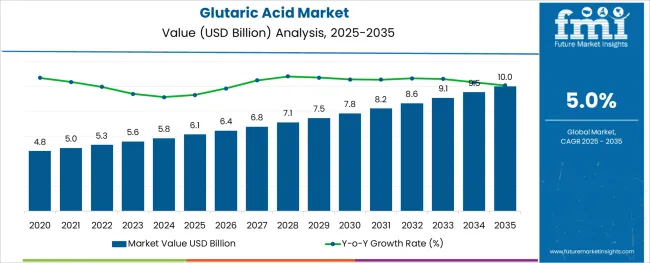
The glutaric acid market is experiencing steady growth, driven by its wide-ranging applications in chemical manufacturing and industrial processes. Industry insights reveal that glutaric acid’s versatility as a building block for polymers, plasticizers, and coatings has led to increasing demand across multiple sectors.
Expansion in the production of specialty chemicals and performance materials has heightened the need for high-purity glutaric acid variants. Regulatory shifts encouraging the use of sustainable and bio-based chemicals have further supported market development.
Increased investments in chemical infrastructure and rising production capacities in emerging economies have contributed to market growth. Looking forward, innovations in green chemistry and downstream applications are expected to sustain demand. Segmental growth is anticipated to be led by Industrial Grade glutaric acid due to its cost-effectiveness and broad utility, along with its predominant use in chemical manufacturing industries.
The market is segmented by Product Grade and End Use Industry and region. By Product Grade, the market is divided into Industrial Grade and Reagent Grade. In terms of End Use Industry, the market is classified into Glutaric Acid for Chemicals, Glutaric Acid for Cosmetics & Personal Care, Glutaric Acid for Healthcare, and Glutaric Acid for Other End Use Industries. Regionally, the market is classified into North America, Latin America, Western Europe, Eastern Europe, Balkan & Baltic Countries, Russia & Belarus, Central Asia, East Asia, South Asia & Pacific, and the Middle East & Africa.
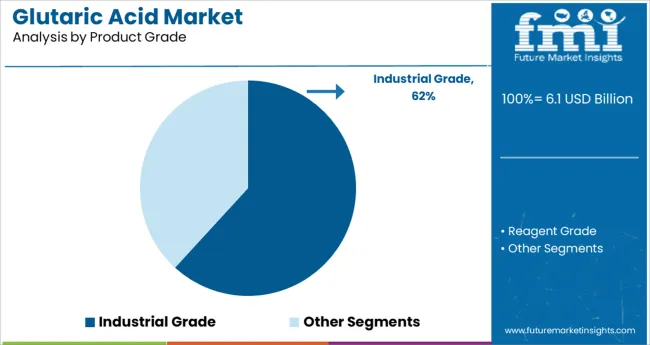
The Industrial Grade segment is expected to account for 61.8% of the glutaric acid market revenue in 2025, maintaining its dominance in product classification. This segment’s growth has been driven by its suitability for large-scale chemical processes where moderate purity levels are sufficient.
Industrial grade glutaric acid is preferred for manufacturing plasticizers, resins, and adhesives, which require cost-efficient raw materials. Its broad applicability across multiple chemical syntheses has made it a staple in industrial production environments.
Additionally, its affordability compared to higher purity grades has expanded its use in mass-market applications. As chemical manufacturers aim for operational efficiency and cost control, industrial grade glutaric acid is expected to remain the leading product segment.
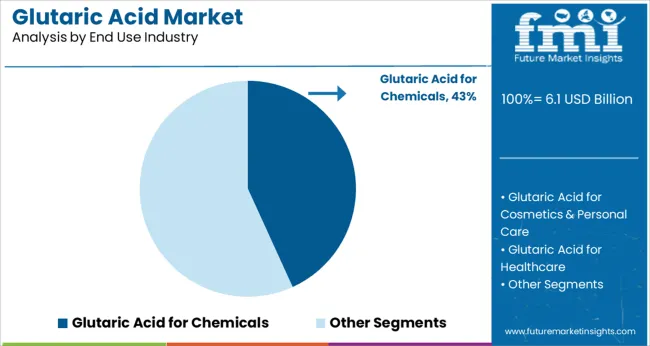
The Glutaric Acid for Chemicals segment is projected to hold 43.2% of the market revenue in 2025, positioning it as the primary end-use industry. Demand in this segment stems from the growing production of polymers, plasticizers, and specialty chemicals where glutaric acid serves as a critical raw material.
The chemical industry's drive toward developing advanced materials with enhanced performance characteristics has increased reliance on glutaric acid-based intermediates. Furthermore, regulatory focus on eco-friendly chemical formulations has encouraged the use of glutaric acid in bio-based polymer production.
Continuous innovation in coatings, adhesives, and elastomers has sustained consumption growth. With ongoing expansion of the chemical manufacturing sector worldwide, glutaric acid for chemicals is expected to maintain its market leadership.
Presently, Glutaric Acid is used as a chemical intermediate to manufacture Polymer materials are in high demand across all end-use industries.
Polyamide-based products are increasingly being used in industries such as automotive, clothing and apparel, sports equipment, and so on. Because of their strength, stress resistance, and flexibility, polyester polyols-based coating and adhesive products are in high demand.
Glutaric acid's use in the production of such critical polymer materials is certain to drive its market growth in the future. Furthermore, glutaric acid is used as an ingredient in the production of surfactants.
Glutaric acid is used in the production of pharmaceutical products and as an ingredient in some dietary supplements in the healthcare sector.
With increasing lifestyle diseases, changing work patterns, and extreme weather conditions due to climate change, there is an increase in demand for pharmaceutical products across all regional markets.
As a result, the demand from the healthcare sector is regarded as another significant growth driver for the Glutaric acid market.
Inflammation issues, combined with high product consumption, will likely cause health issues, acting as a market restraint factor for glutaric acid growth in the projected timeframe.
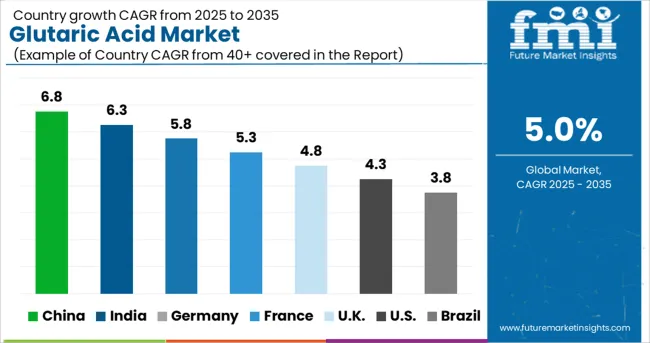
During the forecast period, Asia Pacific is expected to maintain its position. Key industries such as pharmaceuticals, food and beverage, personal care and cosmetics, and others have seen exponential growth in the region.
This can be attributed to rising healthcare spending by governments in emerging economies such as China and India, as well as rising demand for affordable medicines for the general public.
The growing chemical industry in Asia Pacific as a result of rapid industrialization, combined with the abundance of raw materials such as palm oil, is expected to have a positive impact on the global glutaric acid market over the forecast period.
According to Future Market Insights, Europe accounted for a sizable portion of global revenue due to high product consumption in cosmetic applications, particularly in Germany and the United Kingdom.
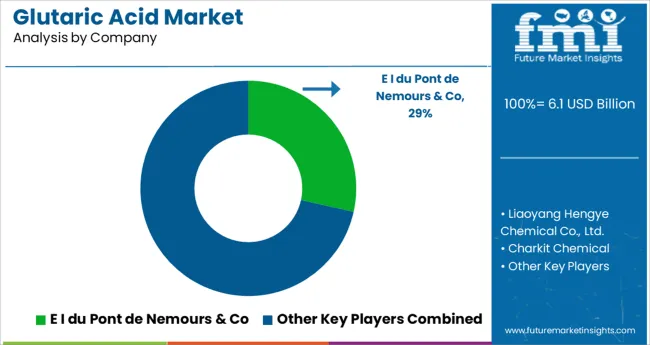
Some of the key participants present in the global Glutaric Acid market include E I du Pont de Nemours & Co, Liaoyang Hengye Chemical Co., Ltd., Charkit Chemical, Kowa India Pvt.Ltd, The Chemical Company, Penta International, TCI AMERICA, Santa Cruz Biotechnology, Carbosynth and BOC Sciences among others.
Attributed to the presence of such high number of participants, the market is highly competitive.
| Report Attribute | Details |
|---|---|
| Growth Rate | CAGR of 5% from 2025 to 2035 |
| Base Year for Estimation | 2024 |
| Historical Data | 2020 to 2024 |
| Forecast Period | 2025 to 2035 |
| Quantitative Units | Revenue in billion, Volume in Kilotons and CAGR from 2025 to 2035 |
| Report Coverage | Revenue Forecast, Volume Forecast, Company Ranking, Competitive Landscape, Growth Factors, Trends and Pricing Analysis |
| Segments Covered | Product Grade, End Use Industry, Region |
| Regions Covered | North America; Latin America; Western Europe; Eastern Europe; CIS & Russia; Asia Pacific; Japan; Middle East & Africa |
| Key Countries Profiled | USA, Canada, Brazil, Argentina, Germany, UK, France, Spain, Italy, Nordics, BENELUX, Australia & New Zealand, China, India, ASEAN, GCC, South Africa |
| Key Companies Profiled | E I du Pont de Nemours & Co; Liaoyang Hengye Chemical Co., Ltd.; Charkit Chemical; Kowa India Pvt.Ltd; The Chemical Company; Penta International; TCI AMERICA; Santa Cruz Biotechnology; Carbosynth and BOC Sciences |
| Customization | Available Upon Request |
The global glutaric acid market is estimated to be valued at USD 6.1 billion in 2025.
It is projected to reach USD 10.0 billion by 2035.
The market is expected to grow at a 5.0% CAGR between 2025 and 2035.
The key product types are industrial grade and reagent grade.
glutaric acid for chemicals segment is expected to dominate with a 43.2% industry share in 2025.






Full Research Suite comprises of:
Market outlook & trends analysis
Interviews & case studies
Strategic recommendations
Vendor profiles & capabilities analysis
5-year forecasts
8 regions and 60+ country-level data splits
Market segment data splits
12 months of continuous data updates
DELIVERED AS:
PDF EXCEL ONLINE
Acid Coil Cleaner Market Size and Share Forecast Outlook 2025 to 2035
Acid Filling and Leveling Machine Market Size and Share Forecast Outlook 2025 to 2035
Acid Chlorides Market Size and Share Forecast Outlook 2025 to 2035
Acid-Sensitive APIs Market Analysis - Size, Share, and Forecast Outlook 2025 to 2035
Acidified Whey Protein Market Analysis - Size, Share & Trends 2025 to 2035
Acid Dyes Market Growth - Trends & Forecast 2025 to 2035
Acidity Regulator Market Growth - Trends & Forecast 2025 to 2035
Acid Proof Lining Market Trends 2025 to 2035
Acid Citrate Dextrose Tube Market Trends – Growth & Industry Outlook 2024-2034
Acid Orange Market
Antacids Market Analysis – Size, Trends & Forecast 2025 to 2035
Lead Acid Battery Market Size and Share Forecast Outlook 2025 to 2035
Lead Acid Battery Recycling Market Size and Share Forecast Outlook 2025 to 2035
Feed Acidifier Market Analysis Size Share and Forecast Outlook 2025 to 2035
Food Acidulants Market Growth - Key Trends, Size & Forecast 2024 to 2034
Boric Acid Market Forecast and Outlook 2025 to 2035
Folic Acid Market Size and Share Forecast Outlook 2025 to 2035
Oleic Acid Market Size and Share Forecast Outlook 2025 to 2035
Dimer Acid-based (DABa) Polyamide Resin Market Size and Share Forecast Outlook 2025 to 2035
Humic Acid Market Size and Share Forecast Outlook 2025 to 2035

Thank you!
You will receive an email from our Business Development Manager. Please be sure to check your SPAM/JUNK folder too.
Chat With
MaRIA